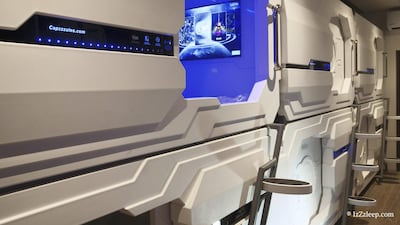I’m in a hotel room, but I’m not writing this Postcard from a desk or even from the edge of my bed.
I can’t stare out the window, hoping pertinent things to write about will come to mind. That’s because this izZzleep Hotel ‘room’ is a 1.8 metres-long by 91 centimetres-high box, one of 40 capsules that have opened as a concept hotel in Mexico City’s Benito Juárez International Airport.
For US$40 (Dh147) a night, you get free Wi-Fi, a fold-down TV and a complimentary pair of socks. Stopping by for a siesta sets travellers back $7.50 for a two-hour minimum stay, and to use a shower costs $6.80, although this is included in the nightly rate.
There’s a memory-foam mattress, temperature control and an alarm to make sure guests don’t miss onward flights, though that’s a feature I don’t risk using – maybe it works fine, maybe it doesn’t; maybe I muck up setting the alarm and oversleep. I deem it not worth experimenting with, and in any case, there are strategically-placed electricity outlets and USB ports for recharging your phones and tablets.
Phone calls are not allowed in or outside of the capsules and guests are not allowed to bring food into the hotel, but on this particular evening, it’s exactly what I need.
Overnighting at the airport spares me from having to face taxis and traffic in a city I’ve never visited before, among people who speak a language I don’t understand.
I don’t have to worry about whether I’ll make my early morning plane onward to Ciudad Juárez because check-in is just a five-minute walk away.
The owners say the idea for opening this type of hotel, that is a first for Central America, came from right in front of their noses.
“We had a job that had us travelling continuously. As frequent travellers waiting for flights and looking at people sleeping on the floor, the idea just came up,” says manager José Martin.
After two years of investigation and development works, izZzleep Hotel came to fruition.
“Although we are far from calling this a business, the results are encouraging: in three months, we’ve had visitors from 64 countries, [of whom] 48 per cent are women and 52 per cent are men.”
Sleep pods and capsule hotels have previously been installed at airports including Abu Dhabi, Naples, Berlin, Helsinki and across Asia.
When a room at a standard airport hotel anywhere in the world can run into hundreds of dollars (the nearby Hilton Mexico City Airport, for example, starts at $170 a night), their budget-friendly prices and unmatchable locations should make them an ideal alternative for travellers.
But as convenient and cheap as they are, the model has never really taken off. They look a bit cool and are certainly a novelty, yet pod accommodation has never hit mainstream.
Maybe it’s their portrayal as a snapshot of life in a distant, dystopian future – take Charlie Brooker’s Black Mirror or any of a host of sci-fi films – that has scared people off.
One reason that comes to mind as I try swinging my right leg up into the top-level capsule is that they’re not particularly easy to get into. “Head first, no, leg first,” I debate with myself (it’s head first, as it turns out).
And while capsule hotels are great for a few hours’ sleep between flights or as a quiet place to chill, you can’t comfortably work on a laptop or, at the izZzleep Hotel at least, down a Big Mac and fries. Or even a salad.
____________
Read more:
Refurbishment is nigh for Godolphin chapel
How Husam Mohammed Jaber became a trailblazer for the return of the besht
The story of Naama Beauty Centre: home to Abu Dhabi's first Moroccan hammam
____________
Major international airports such as Paris Charles de Gaulle and Amsterdam Airport Schiphol have full-length seating and large armchairs in designated ‘quiet zones’ for sleeping that, while hardly ideal for those with a mountain of luggage in tow, meets most travellers’ demands.
izZzleep Hotel manager Martin says the main challenges facing the model are convincing airport authorities of their market potential, and in getting travellers to take to what is a minimalist, Japanese-origin idea. But he is hopeful they will catch on.
“The concept is just starting to be rediscovered, like the case of coffee shops years ago.
“Before Starbucks, only a few countries had lots of coffee shops, but now it seems like every urban space on Earth has one,” he says.
Still, even with the Benito Juárez International Airport last year becoming the second busiest in the Americas, the snaking lines of people to be seen sleeping on its floors point to the fact that $40 is something many still choose not to pay.
For me, at least, it was totally worth it. Before I know it, I’m woken by the alarm on my fully-charged phone, and with thousands of kilometres still to cover in the day ahead, my body feels, mercifully, very well rested indeed.

